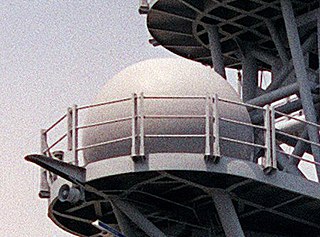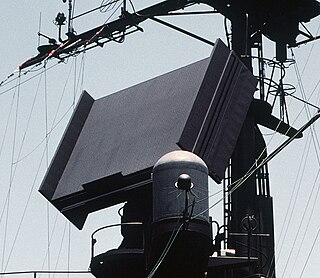
The Charles F. Adams class is a ship class of 29 guided missile destroyers (DDG) built between 1958 and 1967. Twenty-three were built for the United States Navy, three for the Royal Australian Navy, and three for the West German Bundesmarine. The design of these ships was based on that of Forrest Sherman-class destroyers, but the Charles F. Adams class were the first class designed to serve as guided missile destroyers. 19 feet (5.8 m) of length was added to the center of the design of the Forrest Sherman class to carry the ASROC launcher. The Charles F. Adams-class were the last steam turbine-powered destroyers built for the U.S. Navy. Starting with the succeeding Sprance-class, all U.S. Navy destroyers have been powered by gas turbines. Some of the U.S. Charles F. Adams class served during the blockade of Cuba in 1962 and during the Vietnam War; those of the Royal Australian Navy served during the Vietnam War and Gulf War.

The Bendix RIM-8 Talos was a long-range naval surface-to-air missile, and was among the earliest surface-to-air missiles to equip United States Navy ships. The Talos used radar beam riding for guidance to the vicinity of its target, and semiactive radar homing (SARH) for terminal guidance. The array of four antenna which surround the nose are SARH receivers which functioned as a continuous wave interferometer. Initial thrust was provided by a solid rocket booster for launch and a Bendix ramjet for flight to the target with the warhead serving as the ramjet's compressor.

A radar picket is a radar-equipped station, ship, submarine, aircraft, or vehicle used to increase the radar detection range around a nation or military force to protect it from surprise attack, typically air attack, or from criminal activities such as smuggling. By definition a radar picket must be some distance removed from the anticipated targets to be capable of providing early warning. Often several detached radar units would be placed to encircle a target to provide increased cover in all directions; another approach is to position units to form a barrier line.

Leahy-class cruisers were a class of guided missile cruisers built for the United States Navy. They were originally designated as Destroyer Leaders (DLG), but in the 1975 cruiser realignment they were reclassified as guided missile cruisers (CG).

The AN/SPS-48 is a US naval electronically scanned array air search three-dimensional radar system manufactured by ITT Exelis and deployed in the 1960s as the primary air search sensor for anti-aircraft warships. The deployment of the AN/SPY-1 and the end of the Cold War led to the decommissioning of many such ships, and many of these vessels AN/SPS-48 sets were reused on aircraft carriers and amphibious ships, where it is used to direct targets for air defense systems such as the Sea Sparrow and RIM-116 SAM missiles. Existing sets are being modernized under the ROAR program to AN/SPS-48G standard for better reliability and usability.

The AN/SPS-49 is a United States Navy two-dimensional, long range air search radar built by Raytheon that can provide contact bearing and range. It is a primary air-search radar for numerous ships in the U.S. fleet and in Spain, Poland, Taiwan aboard Oliver Hazard Perry-class frigates, Canada on its Halifax-class frigate and New Zealand on its Anzac-class frigates. It formerly served in a complementary role aboard Aegis cruisers with the AN/SPY-1 but the systems are currently being removed during routine upgrade with no replacement.

AN/SPQ-9A,, is a United States Navy multi-purpose surface search and fire control radar used with the Mk-86 gun fire-control system. It is a two dimensional surface-search radar, meaning it provides only range and bearing but not elevation. It is intended primarily to detect and track targets at sea level, on the surface of the water for either gun fire engagement or navigation. It can however, also detect and track low altitude air targets.

The AN/SPS-40 is a United States Navy two-dimensional, long range air search radar that is capable of providing contact bearing and range. It was used on Perth-class destroyers, Forrest Sherman-class destroyers, Charles F. Adams-class destroyers, Spruance-class destroyers, Belknap-class cruisers, Leahy-class cruisers, Knox-class frigates, Bronstein-class frigates, Hamilton-class cutters, Raleigh-class amphibious transport docks and many other ship classes. Its "basket" antenna with the over-the-top feed line was a familiar sight throughout the Navy even into the late 1980s. It was replaced by the AN/SPS-49 on newer ships and on ships that received the New Threat Upgrade.

The AN/SPS-52 is a United States Navy long-range air search 3D radar that is capable of providing contact bearing, range and altitude. It was used on Baleares and Brooke-class frigates, Charles F. Adams and Hatakaze-class destroyers, Tarawa and Wasp-class amphibious assault ships, Galveston, and Providence-class cruisers and other ships. It was replaced by the AN/SPS-48 on newer ships and ships that received upgrades. The antenna is mechanically rotated for azimuth but electronically scanned for elevation.

The AN/SPY-1 is a United States Navy 3D radar system manufactured by Lockheed Martin. The array is a passive electronically scanned system and is a key component of the Aegis Combat System. The system is computer controlled, using four complementary antennas to provide 360 degree coverage. The system was first installed in 1973 on USS Norton Sound and entered active service in 1983 as the SPY-1A on USS Ticonderoga. The -1A was installed on ships up to CG-58, with the -1B upgrade first installed on USS Princeton in 1986. The upgraded -1B(V) was retrofitted to existing ships from CG-59 up to the last, USS Port Royal.

The Guardian-class radar picket ships were a class of ocean radar picket ships, converted 1954–1958 from World War II Liberty ships acquired by the U.S. Navy. Their task was to act as part of the radar defenses of the United States in the Cold War, serving until 1965.

The Type 277 was a surface search and secondary aircraft early warning radar used by the Royal Navy and allies during World War II and the post-war era. It was a major update of the earlier Type 271 radar, offering much more power, better signal processing, new displays, and new antennas with greatly improved performance and much simpler mounting requirements. It allowed a radar with performance formerly found only on cruisers and battleships to be fitted even to the smallest corvettes. It began to replace the 271 in 1943 and was widespread by the end of the year.

OPS-14 is a two-dimensional radar manufactured by Mitsubishi Electric. It is mainly mounted on the Maritime Self-Defense Force's self-defense ship as an anti-aircraft search radar. Variations include OPS-14B and OPS-14C.

OPS-11 is a two-dimensional radar manufactured by Mitsubishi Electric. It is installed as an anti-aircraft search radar on the Maritime Self-Defense Force's escort ship, and it will be the first model originally developed by Japan after World War II for this purpose. Variations include OPS-11B and OPS-11C.

OPS-18 is a two-dimensional radar manufactured by Japan Radio Company. It is installed as an anti-water search radar on the Maritime Self-Defense Force's escort ship. Variations include OPS-18-1 and OPS-18-3.

AN/SPS-6 is a two-dimensional radar manufactured by Bendix and Westinghouse Electric. It was used by the US Navy as a first-generation air-search radar after World War II, and was widely exported to allies. In addition, the improved AN/SPS-12 is the derivative types developed in other countries.

AN/SPS-10 is a two-dimensional radar manufactured by Raytheon Technologies. It was used by the US Navy as a surface-search radar after World War II, and was equipped aboard naval ships during the Cold War. Variants include AN/SPS-10B, AN-SPS/10E and AN/SPS-10F.

AN/SPS-8 is a two-dimensional radar manufactured by General Electric. It was used by the US Navy as a height finding radar after World War II, and was equipped aboard naval ships during the Cold War. Variants include AN/SPS-8A, AN-SPS/8B, AN/SPS-8C and AN/SPS-8D After modernization, it was redesignated as AN/SPS-30.

AN/SPS-29 is a two-dimensional radar was manufactured by General Electric. It was used by the US Navy as a early warning radar after World War II, and was equipped aboard naval ships during the Cold War. Variants include AN/SPS-29A, AN/SPS-29B, AN/SPS-29C and AN/SPS-29D. After modernization, it was redesignated as AN/SPS-37.





















